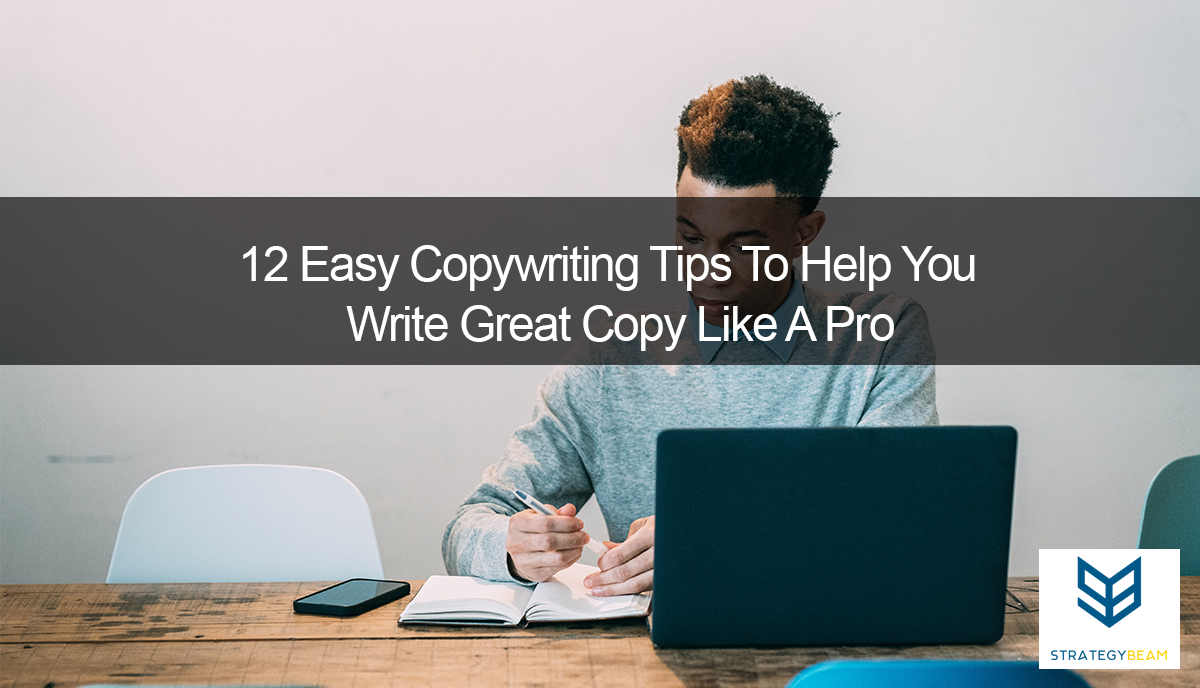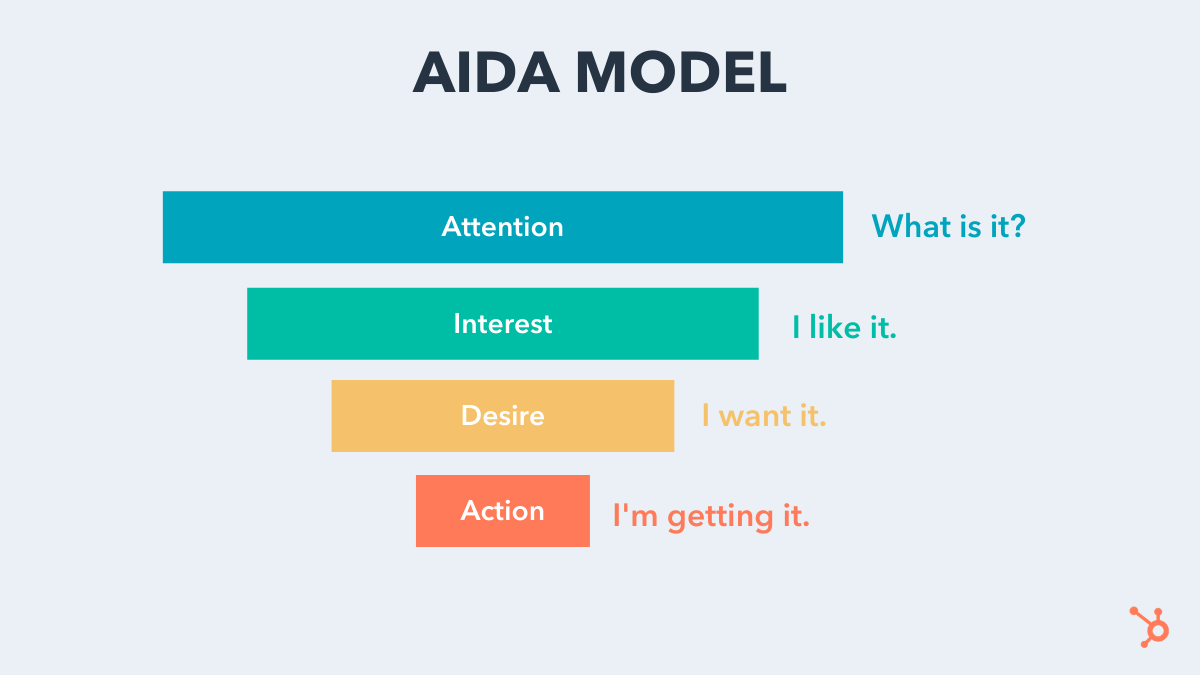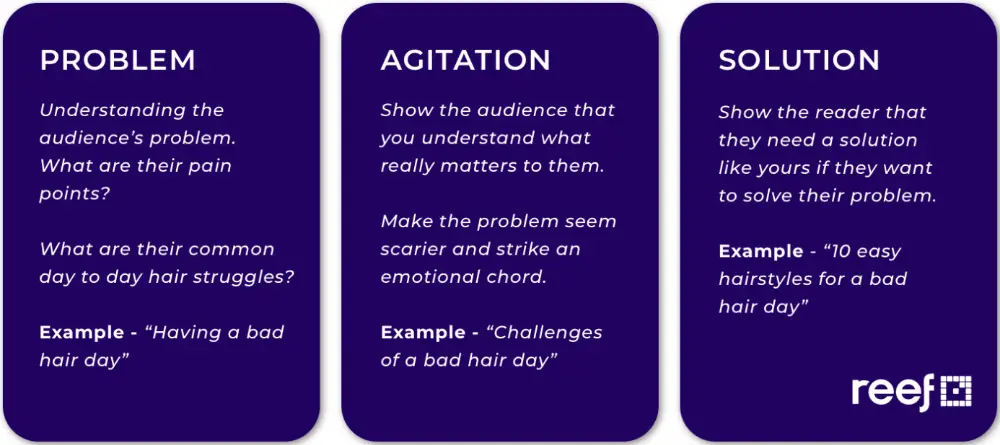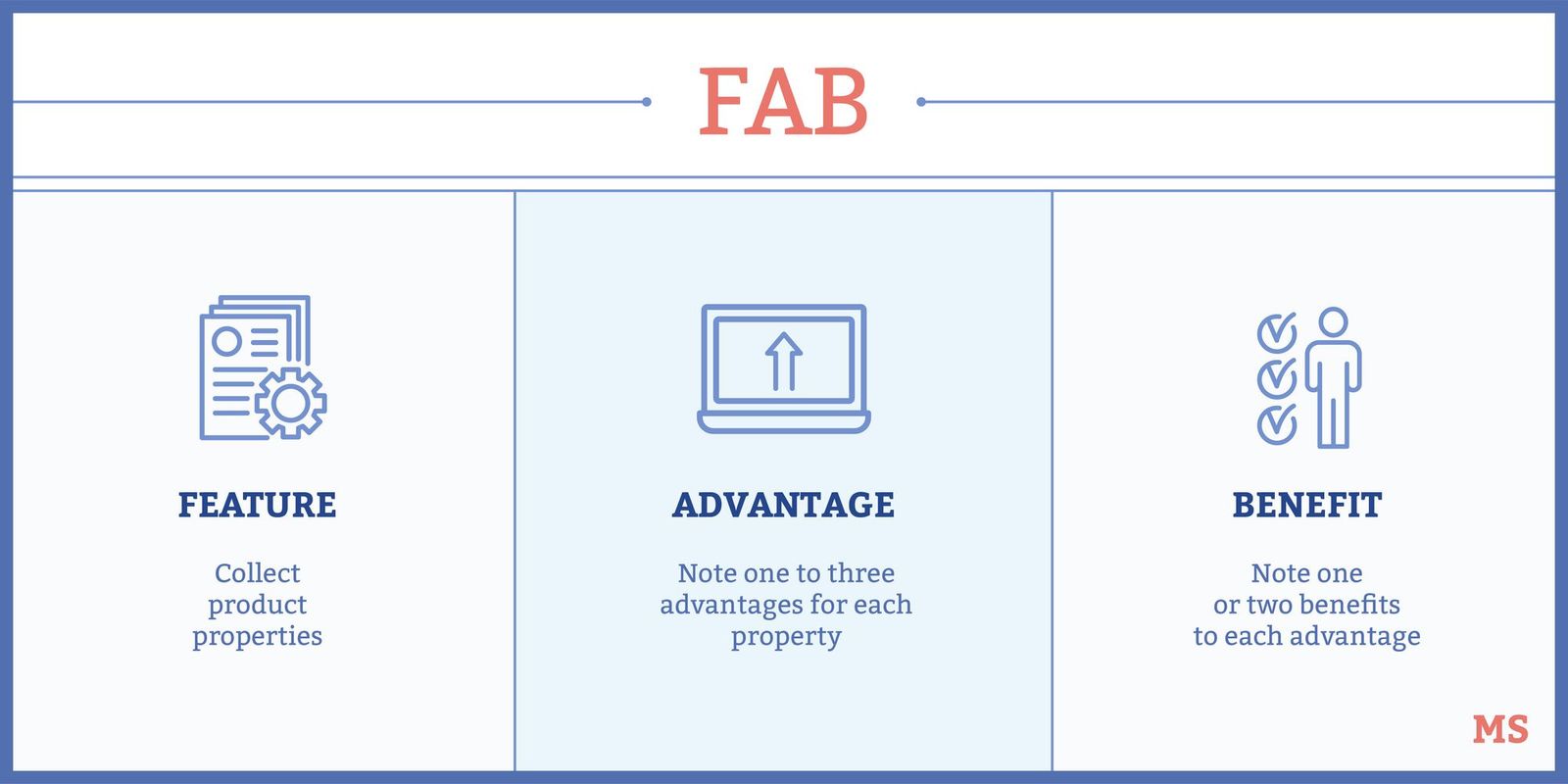
Is your website or brand getting found as potential customers search online for the types of products or services that you offer? Does your content speak to the needs of your audience and build confidence with your ideal audience?
Your future customers are looking for a solution you offer but are overwhelmed by advertising, blog posts, and videos. Great content helps you stand out, and you can use good copywriting tips to connect with your audience.
Some business owners hire a content writer to handle projects, while others choose to write content independently. This guide will help you if you want to write content that ranks in search engine results and drives sales.
Let’s look at why good copywriting is essential and 12 copywriting tips you can use to improve your content today!
Good copywriting is more important than ever before
Good website copywriting does more than merely inform. It compels your audience to take action to engage with your business.
It can transform a casual browser into a committed buyer by communicating the value of a product or service. Plus, good copywriting connects with your audience, fostering trust and loyalty that can lead to repeat business.
Good copywriting could be the difference between securing a sale and losing out to a competitor in a market where consumers are bombarded with choices. It is often the first point of contact between a business and its potential customers.
12 of the best copywriting tips the pros use
Now that we know why great copywriting is vital for your business, let’s look at some of the best copywriting tips you can use to make your content stand out from your competitors and connect with your customers.
1. Create compelling headers
A compelling header is a cornerstone of good copywriting. It’s the first element your audience encounters, setting the tone for the rest of your content which can make a big impact on user experience and conversion rates.
Here are some tips to keep in mind as you craft a compelling headline for your blog posts, website landing pages, or email newsletters.
- Grab attention with powerful words: Use strong, attention-grabbing words that evoke emotions or curiosity. Incorporate words like “ultimate,” “essential,” “proven,” “secret,” or “unleash” to pique readers’ interest and make them eager to learn more.
- Convey a clear benefit or promise: Clearly communicate the benefit or promise that readers will gain from reading your content. Make it evident how your article will solve a problem, provide valuable information, or fulfill a desire. Focus on the value proposition and highlight what sets your content apart.
- Utilize numbers and lists: Incorporate numbers or list-based headlines to attract attention and convey a sense of structure or organization. For example, “10 Ways to Boost Your Productivity” or “5 Essential Tips for Effective Blog Copywriting.” Using numbers in your title or headers can create a clear expectation of what readers will find within the content.
Writing compelling headers can be difficult, but once you put in the time and effort to refine a few ideas, you will be able to grab your audience’s attention and drive more conversions through the process. Here is more information about how to use SEO headers in your blog posts.
2. Has an engaging introduction
A captivating introduction is a crucial component of effective copywriting. Whether it’s blog post copywriting, a web page, or an email marketing campaign, a well-crafted introduction serves as a hook that entices the reader to delve deeper into your content.
The introduction is your first opportunity to grab your audience’s attention. It needs to be engaging and compelling and give a taste of what’s to come throughout the following blog post structure.
Here are a few quick tips that you can use to supercharge your introduction to help draw your readers into your content and entice them to continue reading.
- Start with a captivating hook: Grab your readers’ attention from the very beginning with a compelling hook. This could be an intriguing question, a surprising statistic, a thought-provoking statement, or a compelling anecdote. The goal is to pique their curiosity and entice them to keep reading.
- Establish relevance: Clearly state the relevance of the topic to your readers. Address their pain points, desires, or interests upfront. Let them know why they should continue reading and how the content will benefit them. Make a direct connection between the introduction and their needs.
- Provide a clear preview: Give readers a preview of what they can expect from the rest of the blog post. Highlight the key points, insights, or solutions that will be covered. This sets expectations and helps them understand the value they’ll gain by reading further.
While your headline is typically what gets your readers to click, your introduction is what shows your readers the value of your content and why they should continue engaging with you and your brand.
3. Be conversational
Your audience wants to know that you respect their needs and that you understand who they are before they purchase from you. You can help build a relationship with your readers by writing in a conversational tone.
It can be difficult to write in a conversational tone, so here are some ideas that you can use to write content that is easier for your audience to engage with.
- Use personal pronouns: Incorporate words like “you,” “your,” “we,” and “us” to create a more personal and engaging connection with your readers. This makes your copy feel more like a conversation than a sales pitch.
- Write like you’re speaking to a friend: Try to use natural, conversational language. Avoid jargon and complex phrases. If you wouldn’t say it out loud in a conversation, reconsider including it in your copy.
- Use storytelling: Stories can humanize your brand and make your message more relatable. Share experiences, anecdotes, or customer testimonials to draw readers in.
This conversational approach instills a sense of ownership and potential in the reader. It helps them envision the benefits they would experience by engaging with your product or service.
4. Get to the point
Conciseness is key for great copywriting. It quickly communicates your value proposition, the benefits of your product or service, and the action you want the reader to take.
Many copywriters like to draw out their message because it can be difficult to write in a concise manner, so here are a few tips to keep in mind to help keep your message as concise as possible:
- Start with a clear outline: Before writing, create a detailed outline that organizes your main points and supporting details. This helps you stay focused and ensures that your content flows logically and concisely.
- Use subheadings and bullet points: Break up your content with subheadings and utilize bullet points to present information in a concise and scannable format. This makes it easier for readers to quickly grasp the main points without wading through lengthy paragraphs.
- Be mindful of sentence structure: Write clear and concise sentences that convey your message effectively. Avoid excessive use of complex or convoluted sentence structures. Opt for simplicity and readability by using straightforward language and keeping sentences concise.
By getting to the point, you respect your reader’s time, increasing the likelihood they will engage with your content.
5. Use an active voice
In active voice, the subject of the sentence performs the action, resulting in clear, direct, and engaging writing. For instance, “Our team designed the software” is more dynamic than the passive version, “The software was designed by our team.”
Using active voice in your copy helps in maintaining a brisk, compelling pace, keeping your audience engaged. Unlike a passive voice that makes your content sound boring, an active voice builds a sense of urgency and can be used to communicate a message more effectively in a short amount of time.
If you choose to keep writing in-house instead of working with a professional to outsource copywriting projects, here few tips that I have come to love when writing in an active voice:
- Be direct: Make the subject of your sentence the doer of the action. For instance, instead of saying, “The product can be purchased at our store,” say, “You can purchase the product at our store.”
- Use strong verbs: Instead of relying on adverbs or adjectives for emphasis, use strong, clear verbs. For example, instead of “She ran quickly,” try “She sprinted.”
- Avoid passive voice: Keep an eye out for phrases like “was done,” “were made,” or “has been created.” These usually indicate passive voice. Try to rephrase these in an active voice.
An active voice makes your copy more engaging and your calls to action more effective, boosting audience engagement and conversion and thereby contributing to your business’s success.
6. Create organized content that is easy to read
Structure your content logically, use clear headings, bullet points, and short paragraphs to break up the text, and maintain a consistent flow of ideas.
Whether you are writing a blog post, an email marketing campaign, or sales copy on a landing page, you need marketing copy that is easy to read and guides your readers through your message. Be sure to create a blog post outline to help you share your ideas if you want to write a great blog post, and follow a similar process for other types of content as needed.
Here are some ways you can help format your content in an organized manner that your readers will love:
- Start with an outline: Before diving into writing, create a clear outline that outlines the main sections and key points of your blog post. This helps you organize your thoughts, maintain focus, and ensure a logical flow of ideas throughout your content.
- Use headings and subheadings: Break up your content with headings and subheadings to provide a clear structure and improve readability. Use descriptive and concise headings that accurately summarize the content of each section. This allows readers to skim through your post easily and find the information they need.
- Break up text: Long paragraphs can be intimidating and difficult to read. Use short sentences, paragraphs, and bullet point lists, to break up the text and highlight key points to help your readers easily move through your content.
Content that is easy to follow can increase engagement, improve conversion rates, and build customer trust, all of which contribute to business growth and success. In essence, the organization and readability of your content are crucial components of writing copy that converts.
7. Use visual content
Visuals, such as images, infographics, and videos, can break down complex information into digestible pieces, reinforcing your written content and making your message more memorable. For example, you can use an infographic to share a complex idea, or you can use a video of a product review to build trust with your audience.
Visuals can trigger emotional responses, fostering a deeper connection with your audience and encouraging action.
It can be difficult for many people to think of what images to add to their content, so here are some tips to help you find and place the right type of visual elements in your content:
- Use relevant imagery: Incorporate high-quality, relevant images in your content. Whether it’s a blog post, landing page, or newsletter, visuals can break up text and keep readers engaged. Try using images that directly relate to your topic or illustrate your points.
- Infographics are your friend: Infographics are fantastic for explaining complex ideas or statistics. They can make your content more digestible and appealing, promoting reader comprehension and engagement.
- Leverage video content: If applicable, use short video clips or animations to convey your message. Videos can demonstrate a product, explain a concept, or share customer testimonials, offering a dynamic and interactive element to your copy.
By effectively integrating visual content into your copywriting, you can better captivate your audience, communicate your value proposition, and drive your business goals.
8. Include emotional appeal
You can connect with your audience on an emotional level to make your content more compelling and memorable, leading to better customer engagement and loyalty.
You can make your content more emotional with a few tips:
- Tell a story: Use storytelling to create a deep emotional connection with your audience. Stories can evoke empathy, inspiration, or excitement, making your content more engaging and memorable.
- Use emotional triggers: Words can evoke strong emotions. Using words associated with happiness, urgency, curiosity, or surprise in your headlines and content can capture attention and prompt action.
- Create relatable content: Make your brand feel human and relatable by addressing common challenges or experiences. This can evoke a sense of understanding and camaraderie with your audience.
The emotional appeal allows your copy to resonate with your audience, deepening their connection to your brand and encouraging desired actions.
9. Emphasize benefits instead of features
While features describe what your product or service does, benefits convey the value it provides, answering the essential customer question: “What’s in it for me?”
For example, a feature might be a vacuum cleaner’s powerful motor, but the benefit is hassle-free cleaning and more leisure time because your customers can vacuum their house in less time. Focusing on benefits makes your copy more customer-centric, appealing to their desires, needs, or problems.
Here are some tips to help you focus on benefits instead of features of your products or services:
- Translate features into benefits: For each feature, ask “So what?” until you identify a tangible benefit. For instance, a laptop’s lightweight design (feature) means easy portability (benefit).
- Focus on pain points: Highlight how your product or service can solve a problem or eliminate a pain point. This demonstrates a clear benefit that resonates with your audience.
- Show real-life applications: Use examples or stories to illustrate the benefits of your product or service in real-life situations. This makes the benefits more tangible and relatable.
By showing how your product or service can improve the customer’s life, you can align your value proposition with their motivations, making your copy more effective and your business more successful.
10. Use copywriting formulas
Do you have a hard time trying to figure out where different elements of your content should go in relation to other parts of your message?
If so, then you should consider using a copywriting formula to help write better blog posts, landing pages, and emails.
Copywriting formulas are pre-established structures or templates for creating an effective copy. They provide a proven framework that simplifies the writing process, making it easier to produce compelling and persuasive content.
AIDA Formula
The AIDA formula stands for Attention, Interest, Desire, and Action. It’s a classic copywriting technique that helps you grab your audience’s attention, generate interest in your product or service, evoke desire by demonstrating benefits, and prompt action with a clear call to action.
It’s beneficial as it guides your audience through a psychological journey, leading to conversion. AIDA is versatile and ideal for various content types, such as blog posts, landing pages, email newsletters, and ad copy, making it easy to write compelling content that helps drive engagement with your readers.

Image Source: https://blog.hubspot.com/marketing/aida-model
PAS Formula
The PAS formula stands for Problem-Agitate-Solution, a proven copywriting technique. First, you identify a problem that your audience faces. Next, you agitate the problem by discussing its implications. Finally, you present your product or service as the solution.
This formula is beneficial because it connects with the reader’s pain points and then positions your offering as the remedy. It’s ideal for various content types, including sales pages, email marketing, and blog posts that aim to persuade or sell.

Image Source: https://swipefile.com/the-problem-agitate-solution-pas-copywriting-formula/
FAB Formula
The FAB formula, standing for Features, Advantages, and Benefits, is a popular copywriting technique. It provides a structured approach to presenting your product or service, starting with its features, explaining its advantages, and culminating in the benefits to the customer.
This formula is beneficial because it ensures your copy is customer-centric and persuasive. It’s particularly effective in product descriptions, social media posts, sales pitches, and any content where you need to quickly showcase the value of your offering.

Image Source: https://marketsplash.com/email-copywriting-formulas/
11. Make content memorable and personable
Making your content memorable and personable is a powerful strategy in copywriting. It involves infusing your unique voice, personality, and perspective into your content, making it more engaging and relatable.
For instance, sharing personal anecdotes or using conversational language can make your content stand out. This approach gives your brand a human touch, enabling customers to connect with you as a real person, not just a faceless business.
Here are some ways to make your content memorable and relatable to your audience:
- Show your personality: Let your unique voice and style shine through your content. This could mean using humor, sharing personal stories, or expressing your unique point of view.
- Use conversational language: Write like you speak to make your content more relatable and engaging. Avoid jargon and opt for simple, clear language.
- Inject emotion: Use emotional language to connect with your audience on a deeper level. This can make your content more impactful and memorable.
By making your blog posts, emails, and landing pages uniquely yours, you can differentiate yourself from competitors and create a strong, lasting impression.
12. Editing & proofreading
Editing involves revising your content for structure, flow, and clarity to ensure your message is effectively communicated and your audience remains engaged.
Proofreading, on the other hand, involves checking for spelling, grammar, and punctuation errors. This ensures your content is professional and credible. Mistakes can distract from your message and harm your brand’s reputation.
Here are some quick tips to help you publish better content:
- Take a break: After writing your first draft, take a break before editing. Coming back with fresh eyes can make it easier to spot errors or areas for improvement.
- Read aloud: Reading your content aloud can help you catch awkward phrasing, run-on sentences, or areas that lack clarity.
- Use tools: Leverage digital tools like Grammarly or Hemingway Editor to catch grammar mistakes and readability issues. However, remember these tools aren’t infallible – use your judgment too.
By rigorously editing and proofreading, you can enhance the quality of your content, supporting your business goals in several ways. Clear, well-structured content can better convey your value proposition, boosting conversions.
Create great content with our copywriting tips!
Effective copywriting is an art that can significantly boost your business growth. It’s important to note that you should expect to pay different rates for website copywriting depending on a freelancer’s experience and skillset if you choose to outsource your content writing needs.
With these twelve easy tips, from incorporating visual content and emotional appeal, emphasizing benefits over features, using copywriting formulas, and making content memorable and personable to diligent editing and proofreading, you can transform your copy into a powerful tool.
Ready to create content that drives sales? Don’t do it alone! Contact StrategyBeam today. Our team of expert copywriters can help craft compelling, tailored content that resonates with your audience and boosts your business growth.
Don’t wait – reach out to us now, and let’s start achieving your goals together!

